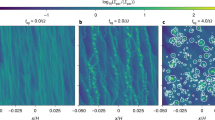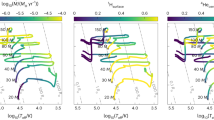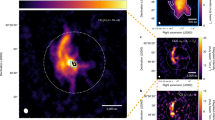Abstract
Families of old tight low-mass binaries in which mass transfer to a heavier collapsed primary from a lighter secondary is an essential evolutionary feature include the galactic bulge X-ray sources, in which the primary is a neutron star. Canonical theories for the evolution of such binaries assume that the mass transfer and secondary evolution are always stable. We argue here that the stability postulate may fail if the secondary mass falls below ∼2×10−2 M⊙. The secondary may then be almost entirely tidally disrupted, leaving behind, at most, a small remnant very much lighter than the Earth in an orbit with a period of several hours. In binary accretion scenarios for the origin of the millisecond pulsar PSR1937 + 2141, this could explain the absence of any detected binary companion.
This is a preview of subscription content, access via your institution
Access options
Subscribe to this journal
Receive 51 print issues and online access
$199.00 per year
only $3.90 per issue
Buy this article
- Purchase on Springer Link
- Instant access to full article PDF
Prices may be subject to local taxes which are calculated during checkout
Similar content being viewed by others
References
Alpar, M. A., Cheng, A. F., Ruderman, M. A. & Shaham, J. Nature 300, 728–730 (1982).
See, e.g., Rappaport, S., Joss, P. C. & Webbink, R. F. Astrophys. J. 254, 616 (1982).
Kopal, Z. Close Binary Systems (Chapman and Hall, London, 1959).
Henrichs, H. & van den Heuvel, E. P. J. Nature 303, 213–216 (1983).
Faulkner, J. Proc. IAU Symp. No. 73 (1976).
Krolik, J. H., Meiksin, A. & Joss, P. C. Preprint (MIT, 1983).
Boriakoff, V., Buccheri, R. & Fauci, F. Nature 304, 417–419 (1983).
Helfand, D. J., Ruderman, M. A. & Shaham, J. Nature 304, 423–425 (1983).
Author information
Authors and Affiliations
Rights and permissions
About this article
Cite this article
Ruderman, M., Shaham, J. Fate of very low-mass secondaries in accreting binaries and the 1.5-ms pulsar. Nature 304, 425–427 (1983). https://doi.org/10.1038/304425a0
Received:
Accepted:
Issue Date:
DOI: https://doi.org/10.1038/304425a0
This article is cited by
-
Planets around pulsars: A review
Astrophysics and Space Science (1994)
-
Jupiters around dead stars and the formation of single recycled radio pulsars
Astrophysics (1990)
-
Pulsars: their origin and evolution
The Astronomy and Astrophysics Review (1989)
-
The formation and evolution of low-mass close binaries with compact components
Astrophysics and Space Science (1987)
Comments
By submitting a comment you agree to abide by our Terms and Community Guidelines. If you find something abusive or that does not comply with our terms or guidelines please flag it as inappropriate.



